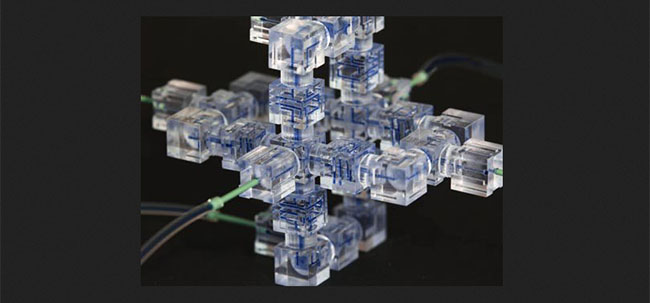Astronomy| Biology | Chemistry | Computer Science
Engineering | Math | Physics
Astronomy

K. E. Saavik Ford
My primary interest is in studying the structures that allow accretion onto black holes and how matter fueling activity arrives in the nucleus. I work on Active Galactic Nuclei (AGN)—galaxies which appear to have an accreting black hole and/or significant star formation in their nuclei. My primary interest is in studying the structures that allow accretion onto black holes and how matter fueling activity arrives in the nucleus. I work with a new kind of optical interferometric technique called non-redundant masking to produce high-contrast, high-resolution images. I also investigate the absorption of gravitational waves.
Barry McKernan
I study the central engine of active galactic nuclei (AGN) using X-ray and infrared observations of AGN to constrain models of accretion onto supermassive black holes. I also carry out theoretical studies of fueling of AGN and is interested in MHD simulations of the central engine. I am part of a team applying a new detector technique to space telescopes in order to image details in AGN. I am interested in the effects of gravitational waves on a variety of astrophysical objects.
Biology

Mario Benavides
Laminopathies are an exceptional group of diseases commonly associated with dysfunctional nuclear lamina, a perinuclear meshwork of intermediate filaments lining the nucleoplasmic side of nuclear envelope. Elucidating the molecular mechanisms that regulate the expression and localization of lamin A/C is relevant and necessary to understand these rare diseases and to design efficient treatment approaches.
Matthew Geddis
Neuronal Complications of Diabetes – As a collaborator with researchers (Dr. Ann Marie Schmidt’s Laboratory) at New York University Medical Center (NYUMC) I have the opportunity to continue my research (mentor, advisor and now collaborator with Dr. Judyta Juranek) examining the role of the receptor for advanced glycation end-products (RAGE) signaling in the deleterious effects of diabetes on the nervous system. The primary focus of this project is to examine how RAGE signaling in the diabetic system alters the primary processes of neuronal regeneration, neuronal survival, formation and outgrowth in vitro and animal models. The current focus is to examine the role of the immune cells in the neuronal regeneration process, research I hope to transition to BMCC.
Alexander Gosslau
Dr Koroch and Dr. Gosslau are jointly running a research pilot project at BMCC named: “Bioactivity of Natural Plant Products” (BNPP). The program serves as proof of concept study which is submitted as grant proposal to NSF-REU (Bioactivity of Natural Plant Products: Advancing Undergraduate Research Among Minorities Enrolled in an Urban Community College). The BNPP program is a multidisciplinary research and learning program which involves students working in collaboration with mentors from various disciplines, providing a unique focus on how to advance scientific knowledge in different areas and integrating these ideas to solve a case-study problem. Students will be engaged in a hands-on experiential approach, which will foster critical thinking to integrate this new knowledge and its application to current research. The BNPP program encourage student interest in a wide range of subject areas (e.g. chemistry, biochemistry, botany, cell and molecular biology, food, nutrition and health) enhancing their interest in research. The BNPP research program involves students working in multidisciplinary research that not only will contribute to learning experiences of students in STEM careers but also advance the knowledge in the plant sciences and human health.
Lalitha Jayant
Dr. Jayant works with the sea urchin Lytechnius variegatus and marine bacteria associated with this urchin. One of her research projects involves extending the shelf-life of sea urchin eggs for laboratory use using liposomes. Given the limited life span of isolated eggs from L. variegatus, one aim of this work has been to make sea urchin gametes more readily available and useful for developmental research and for class experiments in Biology labs. Another aim of the research is to isolate and identify marine bacteria associated with these urchins. Some of these bacteria harbor plasmids and some produce agar and alginate degrading enzymes. Research projects focus on characterizing these bacteria and their plasmids. Dr. Jayant collaborates with Dr. Christine Priano on many projects that involve organisms that coexist in marine environments. Much of the research has been supported by funds from a BMCC Faculty Development Grant, BMCC Publications Grant, and an ASCB Linkage Fellow Grant. BMCC students that have engaged in this research have presented their work at local and national conferences.
Adolfina Koroch
Dr. Koroch also has research interests in regeneration and propagation of unique genotypes of medicinal plants using in vitro culture techniques; the accumulation of natural products under different environmental conditions and in different organs and the biological activity of these natural products. Dr. Koroch is collaborating with Rutgers University researchers on a project searching for the genes associated with disease resistance in basil downy mildew.
Dr. Koroch’s areas of expertise include botany, plant biotechnology, microscopic, chemical and biological identification of medicinal plants and their products. Dr. Koroch also has research interests in regeneration and propagation of unique genotypes of medicinal plants using in vitro culture techniques; the accumulation of natural products under different environmental conditions and in different organs and the biological activity of these natural products. Dr. Koroch is collaborating with Rutgers University researchers on a project searching for the genes associated with disease resistance in basil downy mildew.
Dr. Koroch research expertise has created the environment to motivate and involve students in applied plant research projects thus fostering students’ interest in botanical sciences and science literacy. Dr. Koroch has mentored undergraduate research projects with students participating in C-STEP, L-SAMP, S-STEM and Honor programs at BMCC.
Jun Liang Rice
We are using C. elegans as a model to dissect the molecular aspects of stress response and evaluate how genes affect aging process. Genes regulating stress response affect significantly the efficiency of cancer therapy.One type of cellular stress response often results in cross-protection of other stressor in cells. Stress response genes and pathways could be therapeutic targets for cancers.
Stress affects aging significantly. Genetic mutations resulting in high tolerance of stress cues often live longer, whereas mutations bearing lower tolerance often live shorter. There are various signal pathways that regulate stress response and aging. We are using C. elegans as a model to dissect the molecular aspects of stress response and evaluate how genes affect aging process, in particular the DBL-1 / TGF-beta pathway components.
Genes regulating stress response affect significantly the efficiency of cancer therapy. One type of cellular stress response often results in cross-protection of other stressor in cells. Stress response genes and pathways could be therapeutic targets for cancers. Meanwhile, TGF-beta signaling components are mutated in various cancers at various frequencies. Altered gene expression also plays important role in tumor progression and tumor metastasis. Our studies on TGF-beta signaling components in stress response will impact cancer therapy strategy.
Christine Priano
Dr. Priano’s research involves the examination of microbial life in local fresh water areas and in coastal marine regions. Recent projects have included identifying and characterizing protist life in intertidal environments and examining relationships among organisms that co-inhabit these zones. Student research has focused on determining optimal growth criteria for isolated protists, maintaining laboratory cultures, exploring the response of these mircoorganisms to conditions of environmental stress, and preparing DNA samples for sequence analysis and phylogenetic identification. Dr. Priano also collaborates with Dr. Lalitha Jayant on many projects that involve marine organisms and their ecological roles. This research has been supported in part by funds from a BMCC Faculty Development Grant and a PSC-CUNY Grant. Students that have engaged in this work have presented their research at BMCC’s Annual Poster Presentation Day, the BMCC Sustainability Fair, and at other local undergraduate research conferences.
Brian Rafferty
Dr. Brian Rafferty earned his B.S. and PhD from SUNY Binghamton in Cell and Molecular Biology. His doctoral research focused on the regulation of pro-inflammatory responses in intestinal cells by modifying the cytoskeleton. After completing his PhD work, Dr. Rafferty was a post-doctoral research fellow at Columbia University in the School of Dental Medicine. There he examined oral bacteria and their potential role in cardiovascular diseases, especially those in which arterial plaques are involved. As an Adjunct Assistant Professor at John Jay, Dr. Rafferty collaborated with Dr. Nathan Lents in studying the role of the MZF-1 transcription factor in regulating growth factor expression in hematopoietic cells.
Current Project: My current research focuses on how to regulate the interactions between oral epithelial cells (keratinocytes) and a key bacteria in the development of periodontal disease and gingivitis, Porphyromonas gingivalis. This bacteria’s mechanism of action is to invade oral epithelial cells and subsequently modify the host cell response to promote destruction of the tissue. This project has two avenues: 1. Determine if modifications to the host cytoskeleton will reduce the invasion and pro-destructive nature of the bacteria and 2. Examine the transcriptome (mRNA) changes in both the bacteria and host cell during their interactions with each other. My research is currently being funded through the BMCC Presidential Scholars and a PSC-CUNY grant.
Sarah Salm
Dr. Salm earned her undergraduate and doctoral degrees at the University of the Witwatersrand in Johannesburg, South Africa. After completing her doctorate, she moved to New York for a postdoctoral fellowship in Department of Cell Biology at NYU Langone Medical Center.
Current Project: Dr. Salm’s student-oriented research involves isolating and characterizing bacteria from polluted environments. Currently, her research team is working with several bacteria isolated from the Newtown Creek, a Superfund site in Brooklyn. A number of the isolated bacteria exhibit heavy metal tolerance, thriving on media containing lead, nickel or copper sulfate. Dr. Salm’s team is endeavoring to determine how the bacteria can survive in the presence of these pollutants, with the view to using them as a bioremediation tool.
Catarina Mata
I work mostly with Mediterranean plants, and am interested in drought and photosynthesis that I studied in Mediterranean plants in three continents, and noticed how many plants in these environments have amazing and different mechanisms of drought resistance. If we can trace some drought resistance strategies in the wild plants and apply them into crops, we would have more drought tolerant crops, expanding the areas where they could grow in our increasingly arid planet, and saving on irrigation water.
Dr. Mata is an Assistant Professor and specializes in plant ecophysiology. She obtained her PhD in Utrecht, (The Netherlands) and completed her postdoctoral training in California (UCSB), Italy (INR) and Australia (UWA). I work mostly with Mediterranean plants, and am interested in drought and photosynthesis that I studied in Mediterranean plants in three continents, and noticed how many plants in these environments have amazing and different mechanisms of drought resistance. If we can trace some drought resistance strategies in the wild plants and apply them into crops, we would have more drought tolerant crops, expanding the areas where they could grow in our increasingly arid planet, and saving on irrigation water. Dr. Mata is also interested in the use of stable isotopes 13C and 17O in ecosystems ecology, to detect past drought, and in tracing the products of photosynthesis in leaves. These methods are used to trace the origins of our food, and detect fraud.
Current Project: Dr. Mata is currently working with a student, Blanche Penafiel, on the study of light on the growth, photosynthetic capacity, development, leaf production and oil production of Basil plants (Ocimum basilicum). The seeds and currently germinating.
Molecular mechanism of stress response, aging, cancer therapeutics: My research focuses on functions of TGF-b signaling in animal development. The transforming growth factor-beta (TGF-beta) superfamily consists of a large group of secreted growth factors that regulate various cell responses such as cell arrest, cell proliferation, apoptosis, cell differentiation, tumor genesis, and tumor metastasis. Our studies on TGF-b signaling components in stress response will impact cancer therapy strategy.
Chemistry

Abel E. Navarro
Dr. Navarro eceived his M.S. and Ph.D. in Chemistry at New York University. His doctoral research involved the unfolded state of small peptides. Since undergraduate student, he never resisted the temptation of working in Biotechnology. Now as an Assistant Professor at BMCC, Dr. Navarro is conducting research with talented BMCC students and colleagues from other colleges about bioremediation of environmental pollutants using biological wastes. Abel is aiming the use of low-cost, yet efficient, adsorbents of contaminants from wastewaters. Dr. Navarro is pleased to be part of this big and friendly family, as well as, pioneer the environmental research at BMCC.
Current Projects: Continuous-Flow Adsorption of Contaminants using Natural and Chemically Modified Hydrogels. Continuous-flow experiments are the most suitable techniques for the removal of pollutants from wastewaters. We use ligno-cellulosic materials that are encapsulated in hydrogel matrixes like chitosan and polyalginate to adsorption heavy metals, organic compounds (phenolics), PAHs and other contaminants.
Bioremoval of heavy metals by natural biopolymers. Toxic and common metals like copper and zinc are always present in pipes and industrial wasterwaters. Most of these metals are transparent and cannot be detected by naked eye, which complicates their toxicity. Natural biopolymers are used for their adsorption in discontinuous experiments at room temperature. Time dependent experiments determine the efficiency and mechanism of the removal.
Preparation of soil conditioners from waste materials and eutrophicated waters
Eutrophication (algal bloom) is a major problem in the environment due to the presence of fertilizers (nitrate and phosphate) in high concentrations. Our goal is the sequestration of fertilizers (mainly phosphates) from eutrophicated waters using for the preparation of soil conditioners. These materials will be studied and modified to determine whether they exhibit removal of phosphates from eutrophicated waters (high phosphate levels) and release under different conditions (low phosphate levels).
Chemical sulfurization of natural polymers as an enhancement of adsorptive properties towards metal ions. Incorporation of sulfur as a key element in the structure of well-known biopolymers promises an optimization in the adsorption of metal ions by complexation reactions and high affinity of metals towards sulfur. Recovery of the metals for the re-use of the adsorbent is one of the aims of the project.
Computer Science

Mohammad Azhar
My current research involves the study of dialogues during human robot collaboration. My other research interests include intelligent interface, computer science education, artificial intelligence, educational robotics, educational games, and interactive learning systems.
Hao Tang
Research interests: my research interests are in the fields of 3D Computer Modeling, Visualization of Large-Scale Scene, Image Understanding, Video Mining, Mobile Human-Computer Interaction and Mobile Robot Navigation. This research addresses the important issue of how to optimize the performance of the current 4G (LTE/WiMAX) backhaul infrastructure to cope with the growing and dynamic nature of the emerging data-centric mobile multimedia traffic and services. Specifically, this work would study the performance analysis of LTE networks augmented with pico-cells i.e., heterogeneous networks (HetNets) and supported by the already overlaid PON networks.
Ching-Song Wei
Health/medical data interoperability and exchange in heterogeneous environment: sharing heath data among disparate health information systems by using a cloud framework. Steganography: Optimization of LSB Steganography process using Sample Pair Analysis. Data analytics by using machine learning: Knowledge Extraction for Transportation Data. Geographic Information science (GISc): GISc program development in an urban environment.
Rashid Zaidi
This research addresses the important issue of how to optimize the performance of the current 4G (LTE/WiMAX) backhaul infrastructure to cope with the growing and dynamic nature of the emerging data-centric mobile multimedia traffic and services. Specifically, this work would study the performance analysis of LTE networks augmented with pico-cells i.e., heterogeneous networks(HetNets) and supported by the already overlayed PON networks.
Engineering

Mahmoud Ardebili
Dr. Ardebili is a licensed professional engineer. He is professor and coordinator of the Engineering Science program in the Department of Science at BMCC. Prior to joining BMCC, he taught engineering at City College of New York and Cooper Union in New York City. He frequently conducts seminars for the Fundamentals of Engineering and Professional Engineer licensing examinations. His consulting activities focus on design services in the field of HVAC for architects, construction projects and building managers.
Current Project: Dr. Ardebili has done research separated boundary layer flow with the aim of active control of boundary layer separation using Micro Electro Mechanical Systems. He also conducts research in Self-Sensing of Composite Material. The thrust of the research is to develop technology for Structural Health Monitoring of components manufactured with carbon micro- fiber and / or carbon nanotubes composite material. He also performs research in area of Engineering Education focusing on enhancing retention of engineering majors. He is active in the ASEE (American Society for Engineering Education) and is a frequent presenter at their national conferences. He is a member of ASME, AIAA.
Math

David Allen
Dr. Allen’s research lies at the intersection of Homotopy theory and Algebraic Geometry. His current work revolves around certain aspects of Quillen’s Conjecture which roughly speaking, seeks to determine if some higher order algebraic structures vanish after a certain degree. His research uses objects called Quasitoric manifolds-mathematical objects that are very rich combinatorially and algebraically–to make progress resolving this conjecture. From an applied perspective, Dr. Allen is interested in Topological Data Analysis and Networking Analysis.
Jaewoo Lee
I am mainly interested in combinatorial and additive number theory. I have published a few papers on additive bases, geometry of sumsets, and class activities using Fibonacci sequence for students. I have won numerous grants for these works. I am also interested in other related areas, such as number theory, group theory, combinatorics, dynamical systems, etc.
Chris McCarthy
Applied math: Mathematical models of chemical and biological processes. Examples: adsorption kinetics (chemistry), evolution of treatment resistant pathogens (biology). Pure math: the Hilbert Projective Metric and its applications. Education: Peer mentoring and incorporating mathematical modeling into the teaching of math (especially in association with Simiode.org).
Oleg Muzician
My area of expertise is in Complex Analysis and Complex Dynamical Systems. More precisely, I work with conformally natural extensions of circle maps and their rigidity. Additionally, I study dynamics of rational maps with half-symmetries.
Kathleen Offenholley
Dr. Offenholley’s current research interests include gaming in mathematics education, part of the developing field of games-based learning. She is currently working on a $875,794 NSF grant to create a game-based developmental math course for aspiring STEM majors. She is a steering committee member of CUNY Games Network, which connects educators from every campus and discipline at CUNY who are interested in games, simulations, and other forms of interactive teaching. Additional research areas include developmental and online education.
Claire Wladis
Dr. Wladis’s current research interests are online learning and developmental mathematics education. In particular, she focuses on issues of access and retention in higher education, with a particular interest in students who have traditionally been underrepresented in higher education and in STEM (science, technology, engineering and mathematics) fields. In 2012, she was one of the first community college faculty members to win an American Educational Research Association research award, and she is currently directing a $719,108 NSF grant focused on exploring how student-level factors relate to online course outcomes. She is also in the process of developing and testing an elementary algebra concept inventory, and piloting new approaches to teaching conceptually in elementary algebra. Originally a mathematician, she has also published research in geometric group theory, where she has explored various generalizations of Thompson’s groups and their metric properties.
Marcos Zyman
Research areas: combinatorial group theory; nilpotent, solvable, and exponential groups.
Physics

Shalva Tsiklauri
My major research fields are nuclear physics, hyper and kaonic nuclear physics and physics of the quantum dots. I am applying accurate few-body theoretical method to various systems such as kaonic nuclei and quantum dots.
Particularly, we are researching kaonic nuclear physics. The Kaonicnucleus is composed of an anitikaons, neutrons and protons. The research purpose is to understand interaction between kaon and nucleon in unified way by studying the structure of the kaonic nuclei from the viewpoints of three-and four-body problems.
Chiaki Yanagisawa
My major research fields are particle and particle astrophysics. I am involved two world -class international experiments, the Super-Kamiokande and T2K experiments, conducted in Japan. I also work on super-resolution microscopy for which the 2014 Nobel Prize for Chemistry was awarded.
I am also interested in climate, global warming and sea level rise, cosmic rays and space environment, ice ages and paleoclimate, nerve system, and three dimensional physics animations.

